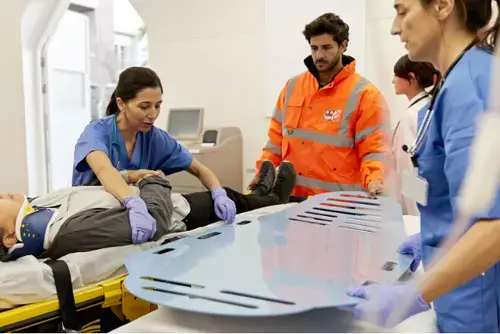HLTOUT001
Implement Safe Access and Egress
- Nationally Recognised Certificate
- Fast Certificate Turnaround
- Experienced and Certified Instructors
- Flexible Learning Options
- Industry Validated

Course Description
The unit HLTOUT001 – Implement Safe Access and Egress – equips individuals with the knowledge and skills necessary to ensure safe entry and exit in various environments, particularly in healthcare, emergency, or community care settings. This unit is essential for professionals working in roles such as paramedics, healthcare workers, or support staff, where safe and efficient access to and from buildings or vehicles is critical for the safety of both clients and workers.
Throughout the course, participants will learn how to assess the safety of access and egress routes, identify potential hazards, and implement strategies to mitigate risks. The training covers safe movement techniques, the use of equipment to assist access (such as ramps or lifting aids), and procedures for ensuring safety when entering or leaving confined spaces or challenging environments. Emphasis is placed on following safety protocols, maintaining situational awareness, and adhering to workplace health and safety regulations.
This unit is ideal for emergency responders, healthcare providers, and support workers who need to manage safe access and egress during their daily tasks.
Upon completing HLTOUT001, participants will be equipped to implement safe access and egress in various situations, ensuring the safety of themselves and others. This training is crucial for maintaining safety standards and preventing accidents in high-risk environments.
Units Delivered
The following units will be included in your certificate:
HLTOUT001
Implement safe access and egress
Additional Information
Course Delivery
This course can be delivered/assessed in the workplace or at facility organised by the training provider.
Course Durations
Entry Requirements
An individual undertaking this course with Allens Training Pty Ltd will need to demonstrate the following to be eligible for entry:
- An official form of photo identification (e.g., driver’s licence, passport, or student ID).
- Physical capability to be able to meet the demands of the practical demonstration skills. This includes safely handling patients and equipment, working in confined or awkward spaces, and performing tasks that may involve bending, lifting, carrying, pushing, or pulling.
- Protective slip resistant footwear/safety shoes and comfortable/practical clothing must be provided by the student and worn during the practical sessions and assessment.
- To successfully complete this course, students will need to demonstrate the following language, literacy, numeracy and digital (LLND) skills during training and assessment:
Learning:Follow instructions, retain information about equipment and its uses, and apply knowledge of safety and welfare requirements for yourself, the patient, and others.
Reading: Locate and interpret information from signs, labels, instructions, manufacturer specifications, and industry guidelines.
Writing: Complete simple workplace documents such as incident reports and patient movement logs using clear, accurate language.
Oral communication: Use clear, respectful language to give and receive instructions, ask questions to confirm understanding, and coordinate safe movement with others.
Numeracy: Measure and record patient height and weight, interpret safe working loads, and apply numerical information to select and adjust equipment correctly.
Digital Literacy: Use a mobile phone or other basic device to access messages, follow online instructions, complete online forms, and access learning resources.
Online learning: Students must have basic digital literacy skills to navigate online platforms, complete assessments, and access course materials. Before enrolment, students should assess their ability to engage in online learning. Support is available where required. The online learning program can be found in the student portal. Students must have access to a computer, smart phone, tablet or other electronic device with access to the internet to complete the online studies and associated assessment tasks.
Delivery mode: Online with face-to-face The online pre-course learning and theory assessment is expected to take approximately 8-9 hours to complete. These timeframes are estimates. Individuals with prior experience in similar training may complete the online component in less time, while those new to the subject may need more time to complete all the learning content and theory questions
Assessment Requirements
Individuals undertaking this course will be expected to complete both written and practical assessment tasks.
Certificate Renewal Requirements
This certificate does not require renewal
Learner Rights, Responsibilities & Support
Please note that enrolment to this course is made with Allens Training Pty Ltd RTO 90909. Please refer to the student handbook on our website for all details relating to rights and responsibilities including complaints and appeals.
Assessment Activities
Practical assessment:
- A team extrication of a conscious casualty
- Assessing, communicating, and implementing safe patient transport to hospital
- Effective monitoring strategies during patient removal
Theory assessment: A written exam consisting of multiple-choice and short answer questions must be completed at the end of the training session. Students must answer all questions.
This course is delivered and assessed on behalf of Allens Training Pty Ltd RTO 90909
Other Training Options
All Courses
Follow Safe Work Practices for Direct Client Care
The unit HLTWHS002 – Follow Safe Work Practices for Direct Client Care – equips individuals with the skills and knowledge to ensure safety when providing direct care to clients in healthcare, aged care, disability services, and community care settings. This unit is essential for workers who are responsible for maintaining their own safety, as well as the safety of clients, while delivering persona...
View Course
Communicate in Complex Situations to Support Health Care
The unit HLTOUT010 – Communicate in Complex Situations to Support Health Care – equips individuals with the skills and knowledge required to effectively communicate in challenging healthcare environments. This unit is crucial for healthcare professionals such as paramedics, nurses, and support staff who need to manage communication in high-pressure or sensitive situations, ensuring clear, compassi...
View Course
Recognise Healthy Body Systems
The unit HLTAAP001 – Recognise Healthy Body Systems – equips individuals with the foundational knowledge of human anatomy and physiology required to understand the normal functioning of the body’s systems. This unit is crucial for workers in healthcare, aged care, disability services, and community care settings, where a solid understanding of healthy body systems is essential for providing effect...
View Course
Manage Personal Stressors in the Work Environment
The unit HLTWHS006 – Manage Personal Stressors in the Work Environment – equips individuals with the skills and strategies to effectively manage personal stress in the workplace, particularly in high-pressure environments such as healthcare, community services, and other care-related industries. This unit is essential for workers who face demanding roles and need to maintain their well-being to pe...
View Course